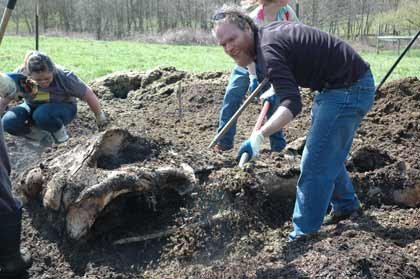That stench wafting on the spring breeze from Chris Wood’s Enumclaw pasture was a combination of manure and decomposing whale.
Yep. Whale.
Working in what resembled a prehistoric archeological dig, Wood, Jeff Bradley, and a few student volunteers spent several days recently uncovering and pulling whale bones out of the compost. Bradley is a collection manager, mammalogy, for the University of Washington’s Burke Museum of Natural History and Culture.
“Composting is common for cleaning and degreasing a skeleton of this size,” Bradley said. He said it’s just difficult to find the space and location to carry it off.
“It’s wonderful of Chris and his wife to put up with it in their pasture.”
In December, the 34-foot Bryde’s whale washed up dead on a beach in Totten Inlet, found in the southern reaches of Puget Sound. It had been injured during a collision with a ship.
Bryde’s are baleen whales that prefer tropical or temperate ocean waters and typically are not seen in the eastern North Pacific north of southern California.
It was the second one in a short period of time to find its way into Puget Sound.
That’s why the Burke Museum is so interested.
“It’s a unique species for Washington waters,” Bradley said.
The whale carcass baked in a combination of wood chips and cow manure, the later courtesy the nearby Gwerder Dairy, beginning Feb. 5. The composting process resulted in temperatures reaching 130 degrees Fahrenheit. Enumclaw High School students in Susan Sanfor’s biology classes helped bury the huge pieces of blubbery flesh and bone.
“If it had been in the mixture much longer the bones would start to decompose,” Bradley said.
Wood, who works with birds at the Burke, was having a whale of a good time being to be part of the process.
His interest started 25 years ago when a 40-ton fin whale washed up in Tacoma and went through the same process in a different farming community.
“That was my introduction and I was enchanted,” Wood said. “You don’t get to see these things very often.”
Although the bones coming out of Wood’s field are headed to the museum, visitors will probably not see them reconstructed as an exhibit.
“It’s not intended for display, but rather research,” Bradley said. “It will be cleaned, stacked and available for research.”



